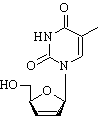Stavudine
Stavudine (2'-3'-didehydro-2'-3'-dideoxythymidine, d4T, brand name Zerit®) is a nucleoside analog reverse transcriptase inhibitor (NARTI) active against HIV. more...
History
Stavudine was approved by the Food and Drug Administration (FDA) in Jun 24, 1994 for adults and in Sep 6, 1996 for pediatric use and again as an extended-release version for once-a-day dosing in 2001. The fourth antiretroviral drug on the market, its patent will expire in the United States on 2008-06-25.
Mechanism of ation
Stavudine is an analog of thymidine. It is phosphorylated by cellular kinases into active triphosphate. Stavudine triphosphate inhibits the reverse transcriptase by competing with natural substrate, thymidine triphosphate. It also causes termination of DNA synthesis by incorporating into it.
The oral absorption rate of stavudine is over 80 %. Approximately half of stavudine is actively secreted unchanged into the urine and the other half is eliminated through endogenic pathways. Simultaneous use of AZT is not recommended, for AZT can inhibit the intracellular phosphorylation of stavudine. Other anti-HIV drugs do not possess this property. The main severe side effect is peripheral neuropathy, which can be corrected by reducing dosage. Stavudine has been shown in laboratory test to be genotoxic, but with clinical doses its carcinogenic effects are non-existent.
Read more at Wikipedia.org



